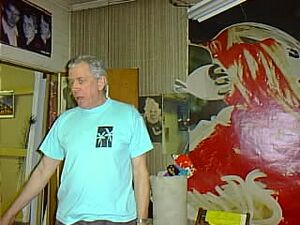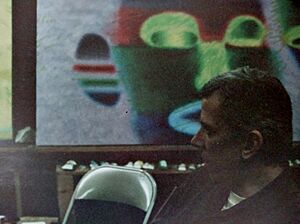Ed Paschke facts for kids
Quick facts for kids
Ed Paschke
|
|
|---|---|
 |
|
| Born |
Edward Francis Paschke
June 22, 1939 |
| Died | November 25, 2004 (aged 65) Chicago, Illinois, U.S.
|
| Education | School of the Art Institute of Chicago |
| Known for | Painting |
Edward Francis Paschke (born June 22, 1939 – died November 25, 2004) was an American painter. He had Polish roots.
As a child, he loved animation and cartoons. His father was also creative, working with wood carving and construction. These interests led Ed Paschke to become an artist.
He studied at the School of the Art Institute of Chicago. There, he was inspired by famous artists like Gauguin, Picasso, and Seurat. Their art was shown in special museum exhibits.
Contents
About Ed Paschke's Life
Ed Paschke was born in 1939 in Chicago. He spent most of his life in this city. He earned his first art degree in 1961. Later, he got his master's degree in art in 1970. Both degrees were from the School of the Art Institute of Chicago.
In 1962, he joined the Army. He worked in a department that created training materials. This included illustrations for books, signs, and guides. These helped new soldiers learn about weapons and procedures.
Teaching and Family Life
In 1976, Paschke began teaching at Northwestern University. He was a kind and helpful professor. He often invited students to his art studio. He even let them paint on his unfinished works. This helped him try new things in his art.
On November 22, 1968, Paschke married Nancy Cohn. They had two children, a son named Marc and a daughter named Sharon.
Ed Paschke lived and worked in Chicago. He passed away at home on Thanksgiving Day in 2004. It seemed to be from heart failure. His wife, Nancy Paschke, was also an artist. She died seven weeks after him in January 2005.
Exploring Ed Paschke's Art
Paschke liked to paint things that looked real. But he also used ideas from abstraction and expressionism. Like many artists in Chicago, he enjoyed outsider art. This is art made by people without formal training. He also liked tattoo art.
He collected many types of pictures. These came from newspapers, magazines, and posters. He also looked at film, TV, and video. He especially liked images that were a bit unusual. He studied how these pictures changed reality. This helped him think about truth and imagination in his own paintings.
Early Paintings and Unique Ideas
In his early art, Paschke often changed famous figures. For example, in Pink Lady (1970), he put Marilyn Monroe's head on a man's body. In Painted Lady (1971), he showed actress Claudette Colbert as a tattooed lady.
He also painted everyday objects in a strange way. He made leather items look like people. Examples include Hairy Shoes (1971) and Bag Boots (1972).
Art Inspired by Electronic Media
Over time, Paschke became interested in electronic media. His paintings started to show TV waves and flashes. Images in his art would break apart. In Matinee (1987), the face of Elvis Presley is broken into glowing colors. Only the lips and eyes suggest a human face.
Paschke used an overhead projector to layer images. Then, he painted them with oil paints. He would first paint in black and white. Then, he added bright colors. He often used special neon-like colors. This process made his art look unique.
Influence and Legacy
Unlike some other artists, Paschke focused on the less glamorous side of American life. He was inspired by Andy Warhol. Warhol also explored themes of fame and money.
In 1984, Paschke's work was featured on the cover of Art in America magazine. His art was seen as a strong alternative to other popular styles. He is now considered an important artist of his time. His unique use of color still inspires artists worldwide.
In 2000, Paschke received a Guggenheim Fellowship. This is a special award for artists.
His art is displayed in many museums. These include the Art Institute of Chicago and the Whitney Museum of American Art in New York. His work is also in the Centre Pompidou in Paris.
Major Exhibitions
- Ed Paschke: Selected Works 1967–1981, Renaissance Society, University of Chicago (1982)
- Ed Paschke Retrospective, Centre Pompidou, Paris (1989–1991)
- Ed Paschke: Recent Work, Illinois Institute of Art - Chicago (2003)
- Ed Paschke: Chicago Icon, A Retrospective, Chicago History Museum (2006)
After his death, many shows featured Paschke's work. In 2010, a major show was held in New York City. It was put together by famous artist Jeff Koons. Koons had been Paschke's assistant in the 1970s. Paschke was a very important mentor to him.
On June 22, 2014, the Ed Paschke Art Center opened in Chicago. It celebrates his art and the work of other Chicago artists.


